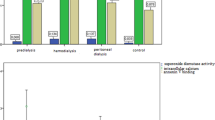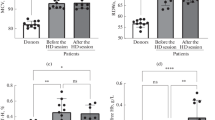Abstract
Anemia in end-stage renal disease (ESRD) results mainly from erythropoietin and iron deficiency. Anemia could be confounded, however, by accelerated clearance of circulating erythrocytes because of premature suicidal erythrocyte death or eryptosis characterized by phosphatidylserine exposure at the erythrocyte surface. Triggers of eryptosis include increased cytosolic Ca2+ concentration ([Ca2+]i), oxidative stress, and ceramide. The present study explored whether and how ESRD influences eryptosis. Blood was drawn from healthy volunteers (n = 20) as well as ESRD patients (n = 20) prior to and after hemodialysis. Phosphatidylserine exposure was estimated from annexin V binding, [Ca2+]i from Fluo3-fluorescence, reactive oxygen species (ROS) from 2′,7′dichlorodihydrofluorescein fluorescence, and ceramide from fluorescein-isothiocyanate-conjugated antibody binding in flow cytometry. Measurements were made in erythrocytes from freshly drawn blood and in erythrocytes from healthy volunteers exposed in vitro for 24 h to plasma from healthy volunteers or ESRD patients prior to and following dialysis. The patients suffered from anemia (hemoglobin 10.1 ± 0.5 g/100 ml) despite 1.96 ± 0.34 % reticulocytes. The percentage of phosphatidylserine-exposing erythrocytes was significantly higher in ESRD patients (0.84 ± 0.09 %) than in healthy volunteers (0.43 ± 0.04 %) and was significantly increased immediately after dialysis (1.35 ± 0.13 %). The increase in phosphatidylserine exposure was paralleled by increase in [Ca2+]i, oxidative stress, and ceramide abundance. As compared to addition of plasma from healthy individuals, addition of predialytic but not of postdialytic plasma from ESRD patients increased phosphatidylserine exposure, [Ca2+]i, ROS, and ceramide abundance. In conclusion, both, dialyzable components of uremic plasma and dialysis procedure, trigger eryptosis at least in part by increasing erythrocyte [Ca2+]i, ROS, and ceramide formation.
Key Messages
-
Anemia in uremia results in part from eryptosis, the suicidal erythrocyte death.
-
Eryptosis in uremia is triggered in part by a dialyzable plasma component.
-
Eryptosis in uremia is further triggered by dialysis procedure.
-
Eryptosis in uremia is in part due to increased cytosolic Ca2+ concentration.
-
Eryptosis in uremia is further due to oxidative stress and ceramide formation.




Similar content being viewed by others
References
Yang M, Fox CH, Vassalotti J, Choi M (2011) Complications of progression of CKD. Adv Chronic Kidney Dis 18:400–405
Dmitrieva O, de Lusignan S, Macdougall IC, Gallagher H, Tomson C, Harris K, Desombre T, Goldsmith D (2013) Association of anaemia in primary care patients with chronic kidney disease: cross sectional study of quality improvement in chronic kidney disease (QICKD) trial data. BMC Nephrol 14:24
Atkinson MA, Furth SL (2011) Anemia in children with chronic kidney disease. Nat Rev Nephrol 7:635–641
Parfrey PS (2011) Critical appraisal of randomized controlled trials of anemia correction in patients with renal failure. Curr Opin Nephrol Hypertens 20:177–181
Fishbane S, Nissenson AR (2010) Anemia management in chronic kidney disease. Kidney Int Suppl 10.1038/ki.2010.188: S3-9
Adamson JW (2009) Hyporesponsiveness to erythropoiesis stimulating agents in chronic kidney disease: the many faces of inflammation. Adv Chron Kidney Dis 16:76–82
Besarab A, Frinak S, Yee J (2009) What is so bad about a hemoglobin level of 12 to 13 g/dL for chronic kidney disease patients anyway? Adv Chron Kidney Dis 16:131–142
Macdougall IC, Ashenden M (2009) Current and upcoming erythropoiesis-stimulating agents, iron products, and other novel anemia medications. Adv Chron Kidney Dis 16:117–130
Wish JB (2009) Past, present, and future of chronic kidney disease anemia management in the United States. Adv Chron Kidney Dis 16:101–108
Yee J, Zasuwa G, Frinak S, Besarab A (2009) Hemoglobin variability and hyporesponsiveness: much ado about something or nothing? Adv Chron Kidney Dis 16:83–93
Artunc F, Risler T (2007) Serum erythropoietin concentrations and responses to anaemia in patients with or without chronic kidney disease. Nephrol Dial Transplant 22:2900–2908
Attanasio P, Ronco C, Anker SD, Cicoira M, von Haehling S (2012) Role of iron deficiency and anemia in cardio-renal syndromes. Semin Nephrol 32:57–62
Besarab A, Coyne DW (2010) Iron supplementation to treat anemia in patients with chronic kidney disease. Nat Rev Nephrol 6:699–710
Kwack C, Balakrishnan VS (2006) Managing erythropoietin hyporesponsiveness. Semin Dial 19:146–151
Kovesdy CP (2009) Iron and clinical outcomes in dialysis and non-dialysis-dependent chronic kidney disease patients. Adv Chron Kidney Dis 16:109–116
Vos FE, Schollum JB, Coulter CV, Doyle TC, Duffull SB, Walker RJ (2011) Red blood cell survival in long-term dialysis patients. Am J Kidney Dis 58:591–598
Lang E, Qadri SM, Lang F (2012) Killing me softly—suicidal erythrocyte death. Int J Biochem Cell Biol 44:1236–1243
Nguyen DB, Wagner-Britz L, Maia S, Steffen P, Wagner C, Kaestner L, Bernhardt I (2011) Regulation of phosphatidylserine exposure in red blood cells. Cell Physiol Biochem 28:847–856
Myssina S, Huber SM, Birka C, Lang PA, Lang KS, Friedrich B, Risler T, Wieder T, Lang F (2003) Inhibition of erythrocyte cation channels by erythropoietin. J Am Soc Nephrol 14:2750–2757
Popolo A, Autore G, Pinto A, Marzocco S (2013) Oxidative stress in patients with cardiovascular disease and chronic renal failure. Free Radic Res 47:346–356
Lau IP, Chen H, Wang J, Ong HC, Leung KC, Ho HP, Kong SK (2012) In vitro effect of CTAB- and PEG-coated gold nanorods on the induction of eryptosis/erythroptosis in human erythrocytes. Nanotoxicology 6:847–856
Maellaro E, Leoncini S, Moretti D, Del Bello B, Tanganelli I, De Felice C, Ciccoli L (2013) Erythrocyte caspase-3 activation and oxidative imbalance in erythrocytes and in plasma of type 2 diabetic patients. Acta Diabetol 50:489–495
Lupescu A, Shaik N, Jilani K, Zelenak C, Lang E, Pasham V, Zbidah M, Plate A, Bitzer M, Foller M et al (2012) Enhanced erythrocyte membrane exposure of phosphatidylserine following sorafenib treatment: an in vivo and in vitro study. Cell Physiol Biochem 30:876–888
Shaik N, Lupescu A, Lang F (2012) Sunitinib-sensitive suicidal erythrocyte death. Cell Physiol Biochem 30:512–522
Ahmed M, Langer H, Abed M, Voelkl J, Lang F (2013) The uremic toxin acrolein promotes suicidal erythrocyte death. Kidney Blood Press Res 37:158–167
Voelkl J, Alzoubi K, Mamar AK, Ahmed MS, Abed M, Lang F (2014) Stimulation of suicidal erythrocyte death by increased extracellular phosphate concentrations. Kidney Blood Press Res 38:42–51
Jilani K, Lupescu A, Zbidah M, Abed M, Shaik N, Lang F (2012) Enhanced apoptotic death of erythrocytes induced by the mycotoxin ochratoxin A. Kidney Blood Press Res 36:107–118
Abed M, Feger M, Alzoubi K, Pakladok T, Frauenfeld L, Geiger C, Towhid ST, Lang F (2013) Sensitization of erythrocytes to suicidal erythrocyte death following water deprivation. Kidney Blood Press Res 37:567–578
Abed M, Herrmann T, Alzoubi K, Pakladok T, Lang F (2013) Tannic acid induced suicidal erythrocyte death. Cell Physiol Biochem 32:1106–1116
Bissinger R, Modicano P, Frauenfeld L, Lang E, Jacobi J, Faggio C, Lang F (2013) Estramustine-induced suicidal erythrocyte death. Cell Physiol Biochem 32:1426–1436
Ghashghaeinia M, Cluitmans JC, Toulany M, Saki M, Koberle M, Lang E, Dreischer P, Biedermann T, Duszenko M, Lang F et al (2013) Age sensitivity of NFkappaB abundance and programmed cell death in erythrocytes induced by NFkappaB inhibitors. Cell Physiol Biochem 32:801–813
Jilani K, Qadri SM, Lang F (2013) Geldanamycin-induced phosphatidylserine translocation in the erythrocyte membrane. Cell Physiol Biochem 32:1600–1609
Lupescu A, Jilani K, Zbidah M, Lang F (2013) Patulin-induced suicidal erythrocyte death. Cell Physiol Biochem 32:291–299
Borst O, Abed M, Alesutan I, Towhid ST, Qadri SM, Foller M, Gawaz M, Lang F (2012) Dynamic adhesion of eryptotic erythrocytes to endothelial cells via CXCL16/SR-PSOX. Am J Physiol Cell Physiol 302:C644–C651
Lang PA, Beringer O, Nicolay JP, Amon O, Kempe DS, Hermle T, Attanasio P, Akel A, Schafer R, Friedrich B et al (2006) Suicidal death of erythrocytes in recurrent hemolytic uremic syndrome. J Mol Med 84:378–388
Palmer SC, Navaneethan SD, Craig JC, Johnson DW, Tonelli M, Garg AX, Pellegrini F, Ravani P, Jardine M, Perkovic V et al (2010) Meta-analysis: erythropoiesis-stimulating agents in patients with chronic kidney disease. Ann Intern Med 153:23–33
Staude H, Jeske S, Schmitz K, Warncke G, Fischer DC (2013) Cardiovascular risk and mineral bone disorder in patients with chronic kidney disease. Kidney Blood Press Res 37:68–83
Foller M, Kasinathan RS, Koka S, Huber SM, Schuler B, Vogel J, Gassmann M, Lang F (2007) Enhanced susceptibility to suicidal death of erythrocytes from transgenic mice overexpressing erythropoietin. Am J Physiol Regul Integr Comp Physiol 293:R1127–R1134
Singh AK (2010) What is causing the mortality in treating the anemia of chronic kidney disease: erythropoietin dose or hemoglobin level? Curr Opin Nephrol Hypertens 19:420–424
Elliott J, Mishler D, Agarwal R (2009) Hyporesponsiveness to erythropoietin: causes and management. Adv Chron Kidney Dis 16:94–100
Acknowledgments
The study was supported by the Deutsche Forschungsgemeinschaft.
Disclosure
All authors of this manuscript declare that they have no competing interests.
Author information
Authors and Affiliations
Corresponding author
Rights and permissions
About this article
Cite this article
Abed, M., Artunc, F., Alzoubi, K. et al. Suicidal erythrocyte death in end-stage renal disease. J Mol Med 92, 871–879 (2014). https://doi.org/10.1007/s00109-014-1151-4
Received:
Revised:
Accepted:
Published:
Issue Date:
DOI: https://doi.org/10.1007/s00109-014-1151-4




